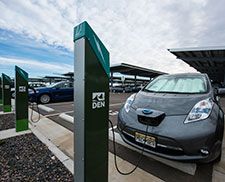Electricity Basics

Electricity is considered an alternative fuel under the Energy Policy Act of 1992. Electricity can be produced from a variety of energy sources, including natural gas, coal, nuclear energy, wind energy, hydropower, and solar energy. This electricity can be stored in batteries or used to produce hydrogen. Electric vehicles (EVs)—the collective term for plug-in hybrid electric vehicles (PHEVs) and all EVs—are capable of drawing electricity from off-board electrical power sources (generally the electricity grid) and storing the energy in batteries. Though not yet widely available, fuel cell electric vehicles (FCEVs) generate electricity from hydrogen onboard the vehicle.
Powering Vehicles with Electricity
In EVs, onboard batteries store energy to power one or more electric motors. These batteries are charged using electricity from the grid and energy recaptured during braking, known as regenerative braking. Vehicles that run only on electricity produce no tailpipe emissions, but there might be upstream emissions associated with the production of electricity.
Using electricity as a power source for transportation is currently cost effective compared to using gasoline, but EVs typically cost more to purchase. However, initial vehicle costs can be offset by energy cost savings, a federal tax credit, and state incentives. Electricity for charging vehicles is especially cost effective if drivers can take advantage of off-peak residential rates and other incentives offered by utilities. The cost is dependent on the price of electricity, which can vary by region, type of generation, time of use, and access point. However, due to the energy efficiency of EV powertrains, additional cost savings over conventional vehicles come from vehicle operation, even when electricity rates are relatively high (i.e., during peak rates or at public fast-charging stations). Learn about factors affecting electricity prices from the U.S. Energy Information Administration.
Electric Charging Stations
Many EV owners choose to do the majority of their charging at home (or at fleet facilities, in the case of commercially owned fleets) where the cost to charge will typically be lower than at public chargers. Some employers offer access to workplace charging. EV drivers also have access to public charging stations in a variety of places, such as shopping centers, public parking garages and lots, hotels, restaurants, and other businesses. Public charging infrastructure is rapidly expanding, providing drivers with the convenience, range, and confidence to meet their transportation needs.


